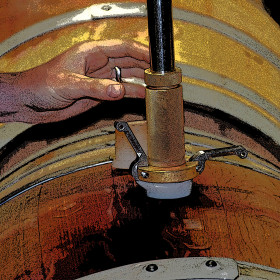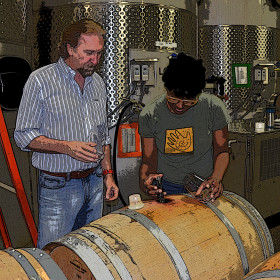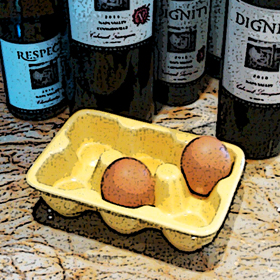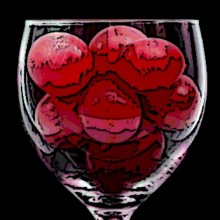Let Me Make This Clear; Racking, Fining & Filtering.
Chapter Twelve, Part Seven.
 Once wine has fermented in a barrel, or been transferred into a barrel for aging from a fermentation vessel made of stainless steel, cement, or your bathtub, sediment will gradually form and settle to the bottom. If this thick, burgundy-hued sludge isn’t separated from the wine it could end up in your wine glass. Then it would only be a matter of time until Riedel introduced a line of spoons to go with their stemware.
Once wine has fermented in a barrel, or been transferred into a barrel for aging from a fermentation vessel made of stainless steel, cement, or your bathtub, sediment will gradually form and settle to the bottom. If this thick, burgundy-hued sludge isn’t separated from the wine it could end up in your wine glass. Then it would only be a matter of time until Riedel introduced a line of spoons to go with their stemware.
To get rid of sediment and other unwanted byproducts, most wine is racked, fined and filtered before bottling.
Last week I attended the racking of eight barrels of Van Dyk Family Wines (VDFW). Before racking, winemaker Victoria Coleman withdrew a sample from each barrel and we compared the flavors and textures imparted by each. VDFW uses French oak barrels grown in different forests, manufactured by various coopers, and produced with assorted toast or char techniques, all of which have a profound effect on the finished wine.
 Racking is the simple process of separating the liquids from the solid lees, or dead yeast cells, and cleaning the barrels before refilling them with wine. A winemaker may opt to siphon wine from one barrel directly into another barrel, leaving the solids behind, or temporarily deposit the wine into a large tank where it is mixed with wine from several other barrels. Once emptied, the barrels are rolled over to disgorge the sediment and then cleaned and dried before refilling with wine.
Racking is the simple process of separating the liquids from the solid lees, or dead yeast cells, and cleaning the barrels before refilling them with wine. A winemaker may opt to siphon wine from one barrel directly into another barrel, leaving the solids behind, or temporarily deposit the wine into a large tank where it is mixed with wine from several other barrels. Once emptied, the barrels are rolled over to disgorge the sediment and then cleaned and dried before refilling with wine.
Much like my grandmother, wine shrinks during the aging process (thankfully it doesn’t start to smell of mothballs like my Grammy). Some wine is discarded with the racked sludge and some evaporates. A beer keg-like container filled with wine is kept on hand to top off the wine in each of the barrels. This keeps the wine from oxidizing which can cause all sorts of problems including the volatile acidity that can turn wine into vinegar.
Fining is another clarification process and it is accomplished by adding a substance to wine that helps suspended particles precipitate to the bottom of the tank so they can more easily be separated from the finished product. Mineral based materials  such as bentonite clay are common fining agents, but animal based products such as gelatin and egg whites have also been widely used for centuries.
such as bentonite clay are common fining agents, but animal based products such as gelatin and egg whites have also been widely used for centuries.
Animal products as diverse as bull’s blood, bone char and sturgeon bladder can be used, causing concern for those on a vegan diet. Some wineries carefully avoid using any animal products and may label their wines ‘vegan-friendly.’ Orleans Hill winery in California produces an organic ‘vegan-friendly’ Syrah that I find pairs particularly well with hanger steak.
Oh calm down. I’m in California where hanger steak is made of tofu.
Before bottling most wines are filtered, even though some wineries feel this can strip wine of its character. I don’t know if this is true because my wife says I don’t have any filters and no one has ever accused me of having character. Filters can be changed of course and a winemaker may opt for a course filtration or a fine filtration. In addition to eliminating large particles, microfiltration can effectively sterilize wine by removing microbial organisms that may affect the stability of wine and possibly spoil it.
Many bottled wines will continue to develop sediment over time, but unfiltered wine may have sediment in the bottle when first released. This doesn’t harm the wine but it doesn’t taste very good either. Be careful not to shake the bottle and be cautious of the final drops as they could be more solid than liquid.
Once while attending a trade tasting of new Piedmont releases I encountered an unexpected ingredient in an unfiltered glass of Barolo. Many of the winemakers had brought freshly bottled barrel samples with them, and as one was poured into my glass I stepped away from the table to taste and analyze. Anxious wine buyers quickly filled my vacated position, cutting off any retreat to the spittoon.
Many descriptive terms cross my mind when I first sample a wine, but in this case my first impression was “solid and slimy”. I was gripped with panic as I looked hopelessly for a reachable spit bucket (have you ever tried to say ‘excuse me’ with a mouthful of Barolo?). I briefly considered spitting the on the carpet but thought that might be frowned upon in a Michelin rated Manhattan restaurant. A bead of sweat was breaking across my brow as I instinctively spit the offending mass back into my glass.
My glass was a frothy lump of a car wreck, but as is the case when you pass a crash scene, I had to look at the carnage. There clinging to the side of my glass  was the slippery offender; a grape!
was the slippery offender; a grape!
Once so relieved I thought of a famous quote from Anthelme Brillat-Savarin who wrote, “A man who was fond of wine was offered grapes at dessert after dinner. ‘Thank you,’ said he, pushing the plate aside, ‘but I am not in the habit of taking my wine in pills,’”






















